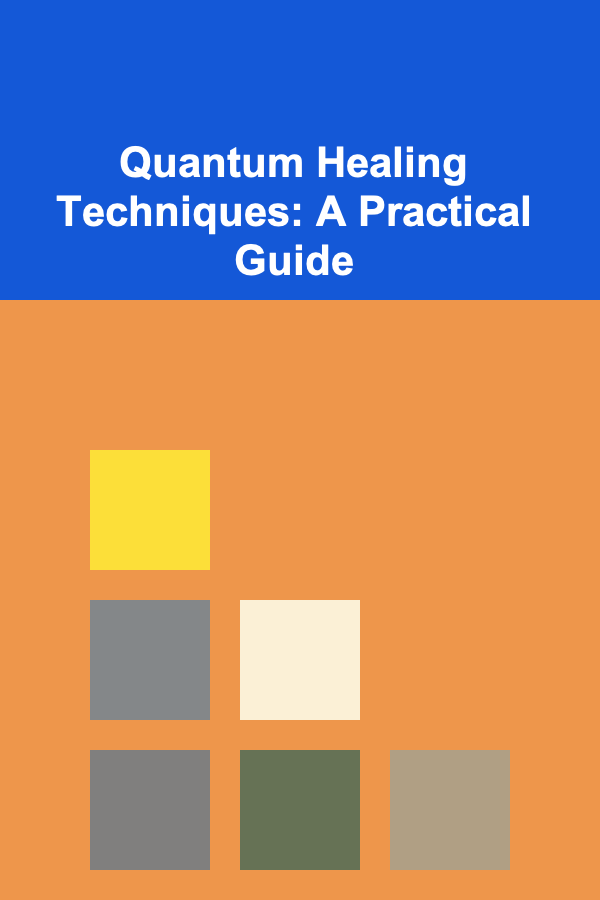
Quantum Healing Techniques: A Practical Guide
ebook include PDF & Audio bundle (Micro Guide)
$12.99$6.99
Limited Time Offer! Order within the next:

Quantum healing, a concept deeply rooted in the principles of quantum physics, suggests that healing can occur by shifting the body's energy fields at a subatomic level. It posits that we are all interconnected energy, and that by influencing this energy, we can impact our physical, mental, and emotional well-being. While the scientific community remains divided on its definitive validation, many individuals find quantum healing techniques to be powerful tools for self-discovery, stress reduction, and overall wellness. This comprehensive guide explores various quantum healing techniques and provides practical advice on how to incorporate them into your daily life. Please remember that these techniques are intended to complement, not replace, conventional medical treatments. Always consult with a qualified healthcare professional for any health concerns.
Understanding the Foundation: Quantum Physics and Consciousness
Before delving into specific techniques, it's crucial to grasp the fundamental concepts upon which quantum healing is based. Quantum physics reveals that the universe isn't a collection of solid, separate objects but rather a dynamic field of energy and information. Key principles include:
- Interconnectedness: Everything in the universe is interconnected at the quantum level. This means that our thoughts, emotions, and actions have a ripple effect on the world around us and vice versa.
- Observation Effect: The act of observation influences the behavior of quantum particles. This suggests that our awareness and intention can shape reality.
- Potentiality: Quantum particles exist in a state of potentiality, meaning they can be in multiple states simultaneously until observed. This implies that we have the potential to choose our reality by focusing our attention on desired outcomes.
- Energy and Vibration: Everything vibrates at a specific frequency. Disease and imbalances are often associated with lower frequencies, while health and well-being are associated with higher frequencies. Quantum healing aims to raise these frequencies.
The role of consciousness in quantum healing is paramount. Consciousness is the observer that collapses the wave function (potentiality) into a specific reality. By becoming more aware of our thoughts, emotions, and beliefs, we can consciously choose to create a more positive and healthy reality.
Core Quantum Healing Techniques
Several techniques align with the principles of quantum healing. These practices focus on shifting energy, altering perceptions, and cultivating a deeper connection with oneself and the universe.
1. Intention Setting and Visualization
Intention setting and visualization are powerful tools for harnessing the observer effect. By clearly defining your desired outcome and vividly imagining it as already realized, you can influence the quantum field and attract that reality into your life.
How to Practice:
- Find a Quiet Space: Choose a comfortable and undisturbed environment where you can relax and focus.
- Relax Your Body: Begin by taking deep, slow breaths to calm your mind and relax your body. You can use progressive muscle relaxation or guided meditation to deepen your relaxation.
- Define Your Intention: Clearly state what you want to manifest. Be specific and positive. For example, instead of saying "I don't want to be sick," say "I am healthy and vibrant." Write down your intention to solidify it.
- Visualize Your Outcome: Close your eyes and imagine your intention as already accomplished. Use all your senses to make the visualization as vivid and real as possible. See yourself enjoying the benefits of your desired outcome. Feel the emotions associated with it -- joy, gratitude, peace, etc.
- Hold the Feeling: Sustain the positive feelings associated with your visualization for as long as possible. These feelings are the fuel that drives your intention into reality.
- Release and Trust: Once you have visualized your outcome and felt the corresponding emotions, release your intention to the universe and trust that it will manifest in its own time and way. Avoid obsessing over the outcome or trying to control every detail.
- Practice Regularly: Consistency is key. Practice intention setting and visualization daily, even if it's just for a few minutes. Over time, you will become more skilled at harnessing the power of your mind to create your reality.
Example: If your intention is to heal from a chronic illness, visualize yourself feeling energetic, strong, and pain-free. Imagine yourself engaging in activities you enjoy, surrounded by loved ones, and feeling grateful for your health. Feel the joy and vitality of being healthy. Repeat this visualization daily.
2. Quantum Entrainment
Quantum entrainment is a technique that involves aligning your brainwaves with a more harmonious frequency, promoting relaxation, reducing stress, and facilitating healing. It utilizes the principle of resonance, where a weaker frequency synchronizes with a stronger one.
How to Practice:
-
Choose an Entrainment Tool: Select a method for entraining your brainwaves. Common options include:
-
Binaural Beats: Listen to audio tracks that play slightly different frequencies in each ear, creating a perceived "beat" that entrains your brainwaves to a specific frequency (e.g., alpha waves for relaxation, theta waves for meditation).
-
Isochronic Tones: Listen to tones that pulse at a specific frequency, stimulating the brain to synchronize with that frequency.
-
Guided Meditations: Participate in guided meditations that use specific language and imagery to induce desired brainwave states.
-
Brainwave Entrainment Devices: Use devices that emit light and sound patterns to entrain your brainwaves (consult with a healthcare professional before using such devices).
-
-
Find a Comfortable Position: Sit or lie down in a comfortable position where you can relax without distractions.
-
Close Your Eyes: Close your eyes and focus on your breath. Take a few deep breaths to center yourself.
-
Listen to the Entrainment Tool: Begin listening to the chosen entrainment tool (binaural beats, isochronic tones, guided meditation, etc.).
-
Focus on the Sound/Guidance: Pay attention to the sounds or guidance provided by the entrainment tool. Allow yourself to be carried along by the experience.
-
Relax and Observe: As you listen, relax your body and mind. Observe any sensations, thoughts, or emotions that arise without judgment. Simply allow them to pass.
-
Continue for 15-30 Minutes: Continue the practice for 15-30 minutes, or as directed by the entrainment tool.
-
Return Slowly: After the session, gradually return to your normal state of awareness. Take a few deep breaths and allow yourself to reorient to your surroundings.
Important Note: Some individuals may experience discomfort or side effects when using brainwave entrainment tools. If you experience any adverse effects, discontinue use and consult with a healthcare professional.
3. Energy Healing Modalities (Reiki, Qigong, Pranic Healing)
Energy healing modalities like Reiki, Qigong, and Pranic Healing work by balancing and harmonizing the body's energy field. These techniques are based on the principle that imbalances in the energy field can lead to physical, mental, and emotional problems. Practitioners use various methods, such as gentle touch, breathwork, and visualization, to clear energy blockages and promote healing.
Reiki:
Reiki is a Japanese healing technique that involves channeling universal life force energy (Reiki) to promote healing. Reiki practitioners use their hands to transmit energy to the recipient, either through direct touch or hovering over the body. Reiki is believed to promote relaxation, reduce stress, and accelerate the body's natural healing process.
How to Practice Self-Reiki:
- Become Attuned: Reiki requires attunement by a qualified Reiki Master. Seek out a certified Reiki practitioner or teacher to receive the necessary attunements.
- Prepare Your Space: Create a quiet and comfortable space where you can relax and focus.
- Set Your Intention: State your intention for the Reiki session. What specific area of your body or life do you want to focus on?
- Ground Yourself: Visualize roots extending from your feet into the earth, connecting you to the earth's energy.
- Call in Reiki Energy: Ask for Reiki energy to flow through you for your highest good and the highest good of all.
- Place Your Hands: Place your hands on various parts of your body, starting with the head and face, then moving down to the chest, abdomen, and limbs. Hold each position for 3-5 minutes or until you feel the energy flow subside.
- Relax and Receive: As you hold your hands in each position, relax and allow the Reiki energy to flow through you. You may feel warmth, tingling, or other sensations. Simply observe these sensations without judgment.
- Give Thanks: After completing the session, express gratitude to the Reiki energy and to your higher self for the healing you have received.
Qigong:
Qigong is an ancient Chinese practice that combines movement, breathing, and meditation to cultivate and balance Qi (life force energy). Qigong exercises are designed to improve circulation, reduce stress, and enhance overall health and well-being.
How to Practice a Simple Qigong Exercise (Standing Meditation):
- Find Your Stance: Stand with your feet shoulder-width apart, knees slightly bent, and tailbone tucked under slightly. Relax your shoulders and arms.
- Relax Your Body: Scan your body for tension and consciously release it. Relax your face, jaw, shoulders, and abdomen.
- Breathe Deeply: Breathe deeply and slowly into your abdomen, allowing your belly to expand as you inhale and contract as you exhale.
- Visualize Energy: Visualize energy flowing into your body with each breath, nourishing your cells and organs. Visualize energy flowing out of your body with each exhale, releasing toxins and negativity.
- Hold the Posture: Maintain this posture for 5-10 minutes, or as long as you feel comfortable. Focus on your breath and the flow of energy in your body.
- End Slowly: Gently move your body and stretch your limbs before returning to your normal activities.
Pranic Healing:
Pranic Healing is a no-touch energy healing system that involves cleansing, energizing, and balancing the body's energy field using Prana (life force energy). Pranic Healing practitioners use their hands to scan the energy field, identify areas of congestion or depletion, and then apply techniques to remove energy blockages and promote healing.
Important Note: While you can learn basic principles of energy healing, becoming a proficient practitioner often requires formal training and certification from a qualified instructor.
4. Meditation and Mindfulness
Meditation and mindfulness practices cultivate present moment awareness, reduce mental chatter, and promote a sense of inner peace. By quieting the mind, you can access deeper levels of consciousness and tap into the body's innate healing abilities. Meditation can also help to regulate the nervous system, reduce stress hormones, and improve overall well-being.
How to Practice Mindfulness Meditation:
- Find a Comfortable Position: Sit or lie down in a comfortable position. You can sit on a cushion, chair, or the floor. Keep your back straight but relaxed.
- Close Your Eyes (Optional): You can close your eyes or keep them softly focused on a point in front of you.
- Focus on Your Breath: Bring your attention to your breath. Notice the sensation of the air entering and leaving your body. Pay attention to the rise and fall of your chest or abdomen.
- Acknowledge Thoughts: As you focus on your breath, your mind will likely wander. Thoughts, feelings, and sensations will arise. Acknowledge these thoughts without judgment. Don't try to suppress them or get carried away by them. Simply notice them and then gently redirect your attention back to your breath.
- Practice Patience: It takes practice to quiet the mind. Be patient with yourself. Don't get discouraged if your mind wanders frequently. Simply keep bringing your attention back to your breath.
- Start with Short Sessions: Begin with short meditation sessions of 5-10 minutes and gradually increase the duration as you become more comfortable.
- End Gently: When you are ready to end the meditation, gently bring your awareness back to your surroundings. Take a few deep breaths and stretch your body.
5. Emotional Freedom Techniques (EFT) / Tapping
EFT, also known as tapping, is a technique that combines elements of acupressure and psychology. It involves tapping on specific meridian points on the body while focusing on a particular issue or emotion. Tapping is believed to release energy blockages in the meridian system, which can alleviate emotional distress and promote healing.
How to Practice EFT:
-
Identify the Issue: Identify the specific issue or emotion you want to address. Be as specific as possible.
-
Rate the Intensity: Rate the intensity of the issue or emotion on a scale of 0 to 10, with 0 being no intensity and 10 being the highest intensity.
-
Create a Setup Statement: Create a setup statement that acknowledges the issue and affirms your self-acceptance. The setup statement typically follows this format: "Even though I have this [issue], I deeply and completely accept myself." For example, "Even though I have this anxiety about public speaking, I deeply and completely accept myself."
-
Tapping Sequence: Tap on the following meridian points while repeating the setup statement three times:
- Karate Chop Point (KC): The fleshy part of the side of your hand, between your wrist and your pinky finger.
-
Tapping Rounds: Tap on the following meridian points while repeating a reminder phrase that summarizes the issue:
-
Eyebrow (EB): The beginning of the eyebrow, closest to the nose.
-
Side of the Eye (SE): On the bony area at the corner of the eye.
-
Under the Eye (UE): On the bony area under the eye, about an inch below the pupil.
-
Under the Nose (UN): The area between the bottom of the nose and the upper lip.
-
Chin Point (CP): The crease in the chin.
-
Collarbone Point (CB): The area just below the collarbone, about an inch from the center of the chest.
-
Under the Arm (UA): On the side of the body, about four inches below the armpit.
-
Top of the Head (TH): The crown of the head.
-
-
Take a Deep Breath: After completing a tapping round, take a deep breath and check in with how you are feeling. Rate the intensity of the issue on a scale of 0 to 10 again.
-
Repeat as Needed: Repeat the tapping rounds until the intensity of the issue decreases significantly or reaches zero.
-
Reframing: If the intensity remains high, try reframing the issue and creating a new setup statement and reminder phrase. For example, instead of focusing on the negative emotion, focus on a positive affirmation or a desired outcome.
6. Gratitude Practices
Gratitude is a powerful emotion that shifts your focus from what you lack to what you have. Practicing gratitude can raise your vibration, increase your sense of well-being, and attract more positive experiences into your life. Gratitude also cultivates a sense of appreciation and contentment, which can reduce stress and improve overall health.
How to Practice Gratitude:
- Keep a Gratitude Journal: Each day, write down three to five things you are grateful for. These can be big or small, significant or mundane. The key is to focus on the positive aspects of your life.
- Express Gratitude to Others: Take time to express your gratitude to the people in your life. Tell them how much you appreciate them and their contributions to your life.
- Gratitude Meditation: Spend a few minutes each day focusing on the things you are grateful for. Visualize the people, experiences, and things that bring you joy and happiness. Feel the emotions of gratitude in your heart.
- Gratitude Jar: Create a gratitude jar and write down things you are grateful for on slips of paper. Place the slips of paper in the jar. When you are feeling down or need a boost, pull out a slip of paper and read it. This can help to shift your perspective and remind you of the good things in your life.
- Practice Gratitude in Daily Life: Make a conscious effort to notice and appreciate the small things in your life, such as the beauty of nature, the taste of your food, or the kindness of a stranger.
Integrating Quantum Healing into Your Life
Incorporating quantum healing techniques into your daily life is a journey of self-discovery and empowerment. Here are some tips for making these practices a sustainable part of your routine:
- Start Small: Begin with one or two techniques that resonate with you and gradually add more as you become comfortable.
- Be Consistent: Consistency is key to experiencing the benefits of quantum healing. Aim to practice these techniques daily, even if it's just for a few minutes.
- Be Patient: Healing takes time. Don't get discouraged if you don't see immediate results. Trust the process and continue to practice with intention and dedication.
- Listen to Your Intuition: Trust your inner guidance and choose the techniques that feel right for you. Experiment with different approaches and find what works best for your individual needs.
- Seek Support: Connect with like-minded individuals or find a qualified practitioner who can provide guidance and support.
- Stay Open-Minded: Be open to the possibility of healing beyond the limitations of conventional thinking. Explore new ideas and approaches with curiosity and a willingness to learn.
- Integrate with Conventional Medicine: Quantum healing techniques are not a replacement for conventional medical treatments. They are intended to complement and enhance your overall healthcare plan. Always consult with a qualified healthcare professional for any health concerns.
Cautions and Considerations
It's important to approach quantum healing techniques with a balanced perspective and to be aware of potential pitfalls:
- Not a Substitute for Medical Care: Quantum healing is not a substitute for conventional medical diagnosis and treatment. It's crucial to seek professional medical advice for any health concerns.
- Avoid Over-Reliance: While these techniques can be powerful, avoid becoming overly reliant on them to the exclusion of other healthy lifestyle choices, such as proper nutrition, exercise, and sleep.
- Potential for Misinterpretation: The subjective nature of these practices can lead to misinterpretations or unrealistic expectations. It's important to maintain a grounded perspective and to avoid making claims that are not supported by scientific evidence.
- Emotional Processing: Quantum healing techniques can sometimes bring up suppressed emotions. Be prepared to address these emotions in a healthy and constructive way. Consider seeking support from a therapist or counselor if needed.
- Ethical Considerations: If you are practicing quantum healing on others, it's essential to adhere to ethical guidelines, such as obtaining informed consent and respecting the client's autonomy.
Conclusion
Quantum healing techniques offer a powerful pathway to self-discovery, healing, and transformation. By understanding the underlying principles of quantum physics and incorporating these practices into your daily life, you can harness the power of your mind to create a more positive, healthy, and fulfilling reality. Remember to approach these techniques with an open mind, a balanced perspective, and a commitment to your overall well-being. As you embark on this journey, trust your intuition, listen to your body, and allow yourself to experience the profound potential of quantum healing.
"The greatest discovery of all time is that a person can change his future by merely changing his attitude." - Oprah Winfrey (While not directly about quantum physics, this quote highlights the power of our mindset in shaping our reality, a core concept in quantum healing).
Reading More From Our Other Websites
- [Personal Care Tips 101] How to Incorporate Essential Oils into Your Personal Care Routine for Maximum Benefits
- [Toy Making Tip 101] Best Stop‑Motion Toy Making: A Complete Guide to Creating Animated Stories with Handmade Toys
- [Horseback Riding Tip 101] Mastering the Basics: Essential Techniques for Controlling Your Horse
- [Organization Tip 101] How to Use Baskets and Trays for Dining Room Storage
- [Home Budget 101] How to Budget for Home Automation Devices & Smart Home Tech
- [Personal Finance Management 101] How to Plan for Retirement in Your 30s and Ensure a Comfortable Future
- [Home Rental Property 101] How to Improve Energy Efficiency in Your Rental Property
- [Needle Felting Tip 101] How to Design Needle‑Felted Wearable Art Pieces That Balance Comfort and Aesthetic Appeal
- [Organization Tip 101] How to Use Seasonal Storage Solutions for Holiday Items
- [Biking 101] Top 5 Bike Races Around the World Every Cyclist Should Experience

How to Build a Soundproof Home Gym
Read More
How to Handle Bookkeeping for Multiple Small Business Clients
Read More
How to Implement Account-Based Sales Strategies for B2B Success
Read More
How to Make a Checklist for Bookkeeping for Non-Profit Organizations
Read More
How to Live a Life of Meaning
Read More
10 Common Christmas Card Addressing Mistakes (and How to Avoid Them)
Read MoreOther Products

How to Build a Soundproof Home Gym
Read More
How to Handle Bookkeeping for Multiple Small Business Clients
Read More
How to Implement Account-Based Sales Strategies for B2B Success
Read More
How to Make a Checklist for Bookkeeping for Non-Profit Organizations
Read More
How to Live a Life of Meaning
Read More